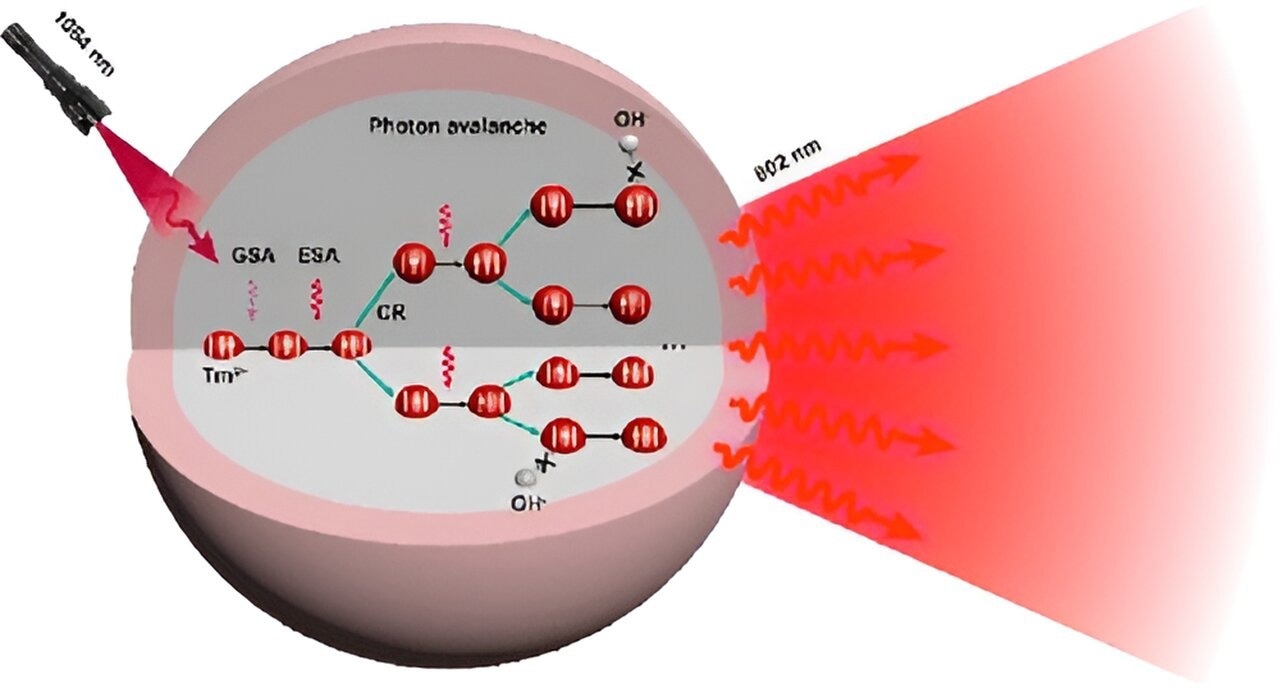Lanthanide (Ln3+)-doped photon avalanche (PA) upconversion nanoparticles (UCNPs) find application in the realms of quantum topics, single-molecule tracking, miniaturized lasers and super-resolution bioimaging.

Credit: Nano Letters (2023). DOI: 10.1021/acs.nanolett.3c02377
Yet, a formidable challenge has persisted in realizing photon avalanche within colloidal Ln3+ doped UCNPs at ambient temperatures, owing to the deleterious quenching effects stemming from surface and lattice OH– defects.
Due to the damaging quenching effect caused by surface and lattice OH– defects, it is still difficult to generate photon avalanches in colloidal Ln3+-doped UCNPs at normal temperatures.
A pioneering methodology for precisely synthesizing Ln3+-doped KMgF3 UCNPs has emerged under the direction of Professor Xueyuan Chen and a research team from the Fujian Institute of Research on the Structure of Matter at the Chinese Academy of Sciences. This method hinges on the pyrolysis of KHF2, and serves as an effective safeguard against the luminescence quenching of Ln3+ by surface and internal OH– defects, subsequently amplifying upconversion luminescence.
The comprehensive findings were officially published in Nano Letters on September 8, 2023.
Remarkably, the researchers demonstrated that the KHF2 precursor adeptly circumvented the creation of OH– defects during the growth of UCNPs. The outcome was a remarkable enhancement in upconversion luminescence within Yb3+/Er3+ and Yb3+/Ho3+ co-doped KMgF3 UCNPs, achieving upconversion quantum yields of approximately 3.8% and 1.1%, respectively. This performance was achieved under 980 nm excitation, with a power density of 20 W cm–2.
Significantly, due to the inhibition of OH– defects and an augmented cross-relaxation rate between Tm3+ ions in the aliovalent Tm3+-doped system, the researchers successfully realized potent photon avalanche luminescence from Tm3+ at 802 nm in KMgF3: Tm3+ UCNPs when subjected to 1,064 nm excitation at room temperature. This achievement boasted a substantial nonlinearity of roughly 27.0, a photon avalanche rise time of 281 ms, and a threshold of 16.6 kW cm–2.
Additionally, the researchers unveiled the distinctive advantages of KHF2 in the controlled synthesis of KMgF3: Ln3+ UCNPs. This methodology endowed the UCNPs with adjustable sizes, heightened crystallinity, fewer surface and lattice defects (primarily OH–), and concurrently amplified upconversion luminescence and near-infrared-II downshifting luminescence efficiencies.
The innovative developments in the controlled synthesis of Ln3+-doped KMgF3 UCNPs, as highlighted in this study, hold immense commercial relevance.
The enhanced efficiency of photon avalanche luminescence and the reduction of defects in these nanoparticles open doors to applications in highly sensitive bioimaging technologies, advanced miniaturized lasers, and precision quantum optics systems. These cutting-edge capabilities are poised to revolutionize industries ranging from medical diagnostics to telecommunications and semiconductor manufacturing.
This groundbreaking study introduces a promising avenue for developing highly efficient photon avalanche UCNPs, showcasing remarkable nonlinearities achieved through aliovalent Ln3+ doping and precise crystal lattice engineering.
Journal Reference:
Zhang, M., et al. (2023) Lanthanide-Doped KMgF3 Upconversion Nanoparticles for Photon Avalanche Luminescence with Giant Nonlinearities. Nano Letters. doi:10.1021/acs.nanolett.3c02377